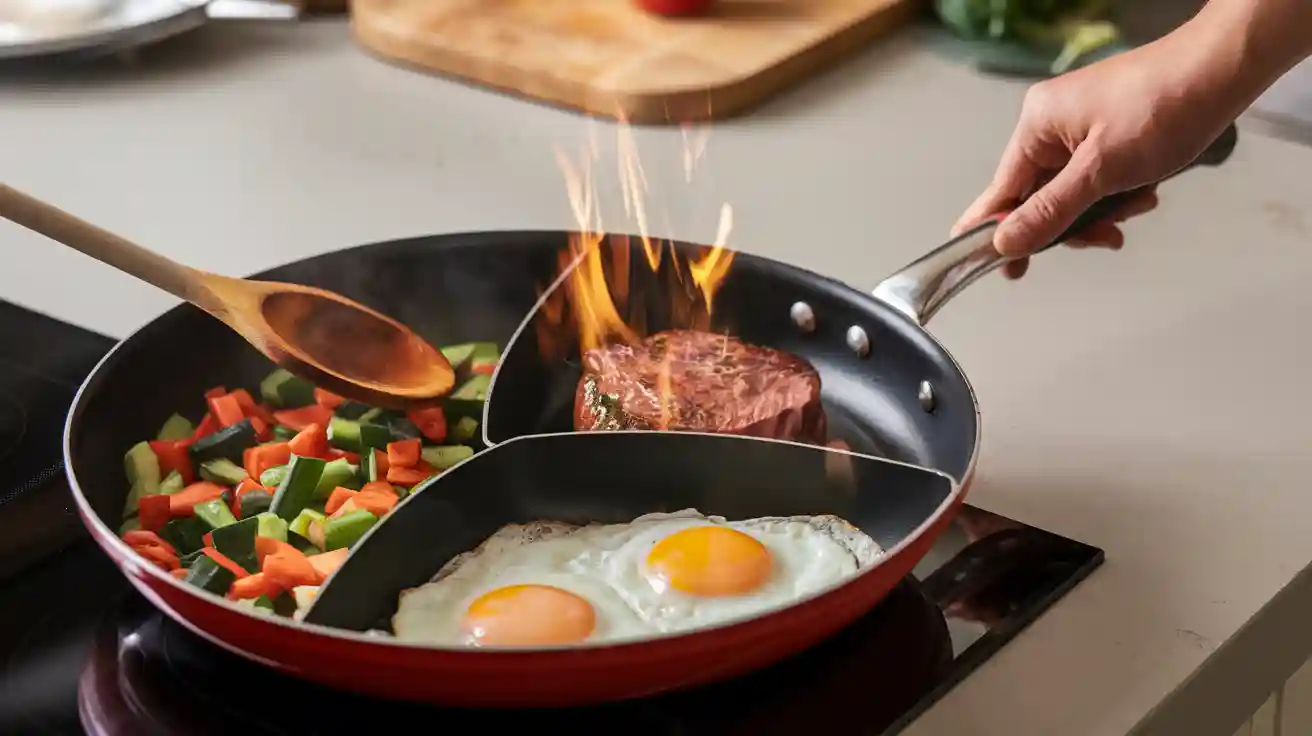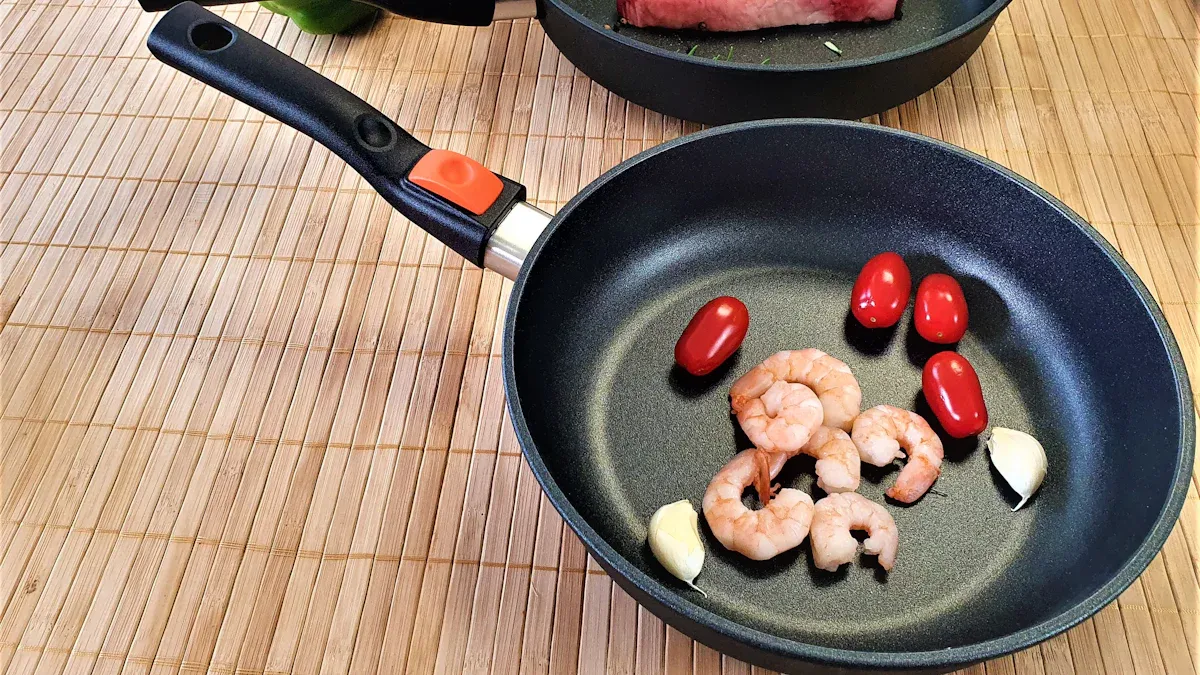
You grab your fry pan and suddenly skillet cooking feels easy. One-pan dishes let you whip up comforting skillet meals for breakfast or dinner. Crack eggs into the skillet, watch them sizzle, and see how skillet cooking makes meal prep fast. With the right recipes, eggs and skillet meals become your go-to for every meal.
Choosing the Best Fry Pan for Skillet Cooking

Essential Features for Versatile Skillet Use
When you want to master essential cooking techniques, choosing the right skillet makes all the difference. You need a fry pan that handles sautéing, searing, and frying with ease. Look for these features:
- Even heat distribution so your food cooks evenly and you avoid hot spots.
- Good heat retention to keep your skillet at the perfect temperature for browning and searing.
- Sloped sides for easy tossing and flipping—great for frying and sautéing.
- Durable material like carbon steel or tri-ply stainless steel for quick heat response.
- Comfortable handle and balanced weight for safe, steady cooking.
- Versatility to move from stovetop to oven.
- Easy maintenance, whether you prefer seasoning carbon steel or quick-clean stainless steel.
Tip: Try the flour test! Sprinkle flour on your fry pan and watch for even browning. This shows if your skillet heats evenly.
Many home cooks feel overwhelmed by the choices. You might wonder if you need a nonstick, cast iron, or stainless steel skillet. Each has its strengths and challenges. Nonstick pans make eggs and fish easy but don’t work well for high-heat searing. Cast iron lasts forever and holds heat but feels heavy and needs seasoning. Carbon steel heats fast and is lighter, but you must care for it to prevent rust. Choosing the right skillet means thinking about your favorite essential cooking techniques and how much maintenance you want.
How Pan Material Impacts Sautéing, Searing, and Frying
The material of your fry pan changes how you cook. Stainless steel, especially tri-ply, heats up fast and spreads heat evenly. You can sear, sauté, and even make pan sauces without worry. Cast iron holds heat for a long time, which helps when you want a deep sear or need steady heat for frying. It takes longer to heat up but keeps food warm. Enameled cast iron skips the need for seasoning and still works well for many essential cooking techniques.
Carbon steel gives you a lighter skillet that heats quickly and works for all three techniques. You just need to keep it seasoned. Nonstick pans make cleanup easy and work best for gentle cooking, but they don’t handle high heat or last as long.
Here’s a quick look at how different skillets compare:
| Pan Type | Sautéing | Searing | Frying | Maintenance & Notes |
|---|---|---|---|---|
| Nonstick | Best for eggs, fish; easy clean | Not for high heat | Great for low-fat frying | Needs gentle care; coating wears out |
| Cast Iron | Good for slow cooking | Excellent for deep searing | Holds heat for frying | Heavy; needs seasoning; lasts generations |
| Stainless Steel | Versatile; needs some technique | Great for browning and sauces | Quick, even heating | No seasoning needed; easy to clean |

You can see why a skillet becomes a versatile staple in your kitchen. When you match the right fry pan to your favorite cooking techniques, you make every meal easier and more delicious.
Skillet Recipes: Sauté, Sear, and Fry Techniques for Every Meal
You can make almost any meal with just one pan if you know the right techniques. Sautéing, searing, and frying help you create comforting skillet meals that taste great and save time. Let’s look at how you can use your skillet for breakfast, lunch, and dinner.
Sautéing Breakfast Favorites in Your Skillet
Sautéing is a fast way to cook breakfast foods. You use a small amount of oil and high heat. This method gives your food a golden crust and keeps the inside soft. You get crispy potatoes, caramelized onions, and perfectly cooked eggs. Here are some breakfast skillet ideas you can try:
- Shredded hash brown potatoes
- Diced onions and bell peppers
- Mushrooms and spinach
- Crispy bacon or sausage
- Sunny side up eggs or scrambled eggs
You can toss these ingredients together for a quick vegetable-forward side dish or a full meal. Sautéing keeps the flavors bright and the textures balanced. You get a crispy outside and a tender inside. If you want to layer flavors, start with bacon or sausage, then add onions and peppers, and finish with eggs.
Tip: Don’t overcrowd your pan. Give each piece space to brown. Use oils with high smoke points, like canola or clarified butter, to avoid burning.
Sautéing also helps keep your meals healthy. Unlike deep frying, it uses less oil and keeps more vitamins and minerals in your food. Cooking vegetables in olive oil boosts their antioxidants, making your breakfast both tasty and nutritious.
Searing for Flavorful Lunches with a Fry Pan
Searing locks in flavor and gives your lunch a delicious crust. You use high heat and a small amount of oil. This technique works best for proteins like chicken, pork, or steak. Here’s how you can get the best results:
- Pat your meat dry before cooking. Moisture stops a good sear.
- Preheat your skillet until it’s very hot.
- Add a thin layer of oil with a high smoke point, like avocado or peanut oil.
- Place the meat in the pan and don’t move it until a crust forms.
- Flip once and let the other side brown.
- Let your food rest before slicing to keep it juicy.
Some favorite skillet recipes for lunch include:
- One-Pan Pork Tenderloin with Potatoes, Tomatoes, and Spinach
- Lemon-Garlic Skillet Chicken and Potatoes
- Skillet Rosemary Chicken with mushrooms and potatoes
- Herb-Marinated London Broil with garlicky greens
Searing creates a caramelized crust that adds deep flavors and keeps the inside moist. You can also sear vegetables for a quick lunch. Cut them into small pieces for even cooking. Avoid overcrowding the pan so everything browns instead of steams.
Note: Don’t flip your meat too soon. Wait until it releases easily from the pan. This helps you get the best crust and flavor.
Searing doesn’t change the nutrition much, but it does make proteins easier to digest and adds a lot of taste. You can use these techniques for both lunch and dinner options, making your meals more exciting.
Frying Comforting Skillet Meals for Dinner
Frying in a skillet gives you crispy, golden results. You can make classic comfort foods or new favorites. To fry well, keep your oil at the right temperature—about 375°F. Use oils like canola, peanut, or avocado for the best results. Start with room temperature ingredients so everything cooks evenly.
Popular dinner recipes that use frying include:
- Fried Green Tomatoes
- Cast Iron Fried Chicken
- Classic Chicken-Fried Steak
- Cast Iron Smash Burgers
- Pan-Roasted Fish with Herb Compound Butter
You can also try skillet recipes like Stovetop Skillet Pizza or Easy, Creamy Beef and Shells for your weeknight dinner rotation. These meals use frying or searing to create rich flavors and crispy textures.
Tip: Drain fried foods on a wire rack or paper towels to keep them crispy. Store leftovers in airtight containers and reheat at 350°F to keep the texture.
The oil you choose matters. Neutral oils like canola let the natural flavors shine. Peanut oil adds a mild nutty taste. Avocado oil gives a subtle buttery flavor. Oils high in monounsaturated fats are healthier and more stable for frying.
Balancing flavors and textures is key to comforting skillet meals. Use seasoning to bring out the best in your ingredients. Try adding fresh herbs or a squeeze of lemon at the end for a bright finish.
With these techniques, you can turn simple ingredients into delicious meals. Your skillet becomes the star of your kitchen, helping you create meals that everyone will love.
Caring for Your Fry Pan to Keep Skillet Cooking Easy
Cleaning and Maintenance Tips
Taking care of your fry pan keeps skillet cooking fun and stress-free. You want your pan to last and always perform its best. Even if your nonstick pan says it is dishwasher safe, hand washing works better. Use warm, soapy water and a soft sponge to protect the coating and keep your pan looking new.
For stainless steel and cast iron pans, follow these steps:
- Let the pan cool before washing. This helps prevent warping.
- Wash by hand with warm, soapy water and a soft sponge. Skip steel wool or harsh pads.
- For stuck-on food, soak the pan with warm water and baking soda, then scrub gently.
- Dry your pan right away with a towel to stop rust, especially on cast iron.
- Avoid the dishwasher to protect your pan’s surface.
If you use a carbon steel pan, let it cool first. Soak it briefly in warm water, then scrub with a soft brush. Dry it well and rub on a thin layer of oil before storing.
You should also wipe down the outside of your pan after each use. Once a week, give your pan a deep clean to remove grease and buildup. Check for damage every month to keep your skillet cooking safe.
| Frequency | Task Description |
|---|---|
| Daily | Wipe down the exterior after each use to prevent residue buildup and maintain cleanliness. |
| Weekly | Perform a deep clean by draining oil, scrubbing interior and exterior to remove grease and grime. |
| Monthly | Inspect fryer components for damage or wear to ensure proper function and safety. |
Tip: Never wash a hot pan with cold water. Sudden temperature changes can warp your skillet.
Extending the Life of Your Skillet
You can make your fry pan last for years with a few simple habits. Always heat your pan slowly on low or medium heat. This helps the metal expand evenly and keeps it from warping. Match the pan size to your burner for even cooking.
Use wooden, silicone, or hard plastic utensils. Metal tools can scratch and damage the surface. Dry your pan right after washing to stop rust and water spots. Store cast iron with a paper towel or plastic separator between the lid and body to let air flow.
If you have a cast iron skillet, regular seasoning makes a big difference. Seasoning means adding a thin layer of oil and heating the pan. This creates a smooth, non-stick surface and protects against rust. Over time, your skillet cooking gets easier and food slides right off.
Here are some common mistakes to avoid:
- Washing a hot pan or rinsing with cold water
- Using metal utensils on nonstick pans
- Overheating your pan, especially nonstick
- Skipping regular seasoning for cast iron
- Stacking pans without protection
Following these tips for perfect skillet meals helps your pan stay in top shape. With good care, you can enjoy skillet cooking for breakfast, lunch, and dinner for many years.
Mastering sautéing, searing, and frying with one pan lets you turn simple foods into tasty, restaurant-style meals. You save space and time because you only need one skillet for many tasks.
With practice, you boost your skills, cook healthier, and enjoy less kitchen clutter every day.
FAQ
Can I use metal utensils with my skillet?
You should avoid metal utensils. They can scratch nonstick or seasoned surfaces. Try wooden or silicone tools instead. Your pan will last longer.
What oil works best for high-heat searing?
Avocado oil or peanut oil works great. These oils handle high heat without burning. You get a better sear and more flavor.
How do I stop food from sticking to my pan?
Make sure your pan is hot before adding food. Dry your ingredients well. Use enough oil. Let food release naturally before flipping.


